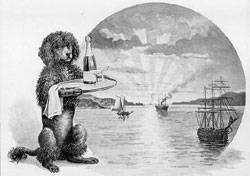
|
|
|
|
|
|
|
|
|
|
|

Read how Jim Smith helped reunite a number of historical documents with the descendents of The Poodle Dog Restaurant. France offered San Francisco some of her best. The restaurant industry there brutalized aspiring chefs with too many top chefs competing for a stagnant number of restaurants given their somewhat stable population. New York grew slowly, attracting primarily poor immigrants. Bustling New Orleans offered better opportunities as the stepping off and return port for Panama and California but that also made it easy to get from there to San Francisco where the real money lay. The French chefs quickly found themselves a home that appreciated and lauded their skills. Alexandre Dumas, author of The Three Musketeers, wrote, "After Paris, the city with the most restaurants is San Francisco. It has restaurants from every country, even China." Dumas died in 1870, his comment finally published in his Le Grand Dictionaire de Cuisine in 1873. By 1912, San Francisco listed 438 restaurants in operation.  The Poodle Dog restaurant opened in 1849; one of San Francisco s first, certainly its most
famous French restaurant. The origin of the name remains obscure. One legend claims the
restaurant gained its name from the owner s longhaired pet poodle because the locals just
wouldn't attempt the French name. An old Frenchwoman ran the Rotisserie-style restaurant. She
offered the comforts of a civilized meal and returning miners quickly opened their pouches of
gold dust to sit at her table. Diners would suggest, "Let s go to the Poodle Dog," and
the name fell into popular use. Another story suggested the poodle was a stray that hung around
the establishment soon to be adopted as the restaurant s mascot. A third story put forth that a
Frenchman who arrived from New Orleans in 1849 managed the restaurant of this tale, Le Poulet d'
Or. Since many of the miners were only semi-literate, sounding out the name produced Poodle Dog.
The Poodle Dog restaurant opened in 1849; one of San Francisco s first, certainly its most
famous French restaurant. The origin of the name remains obscure. One legend claims the
restaurant gained its name from the owner s longhaired pet poodle because the locals just
wouldn't attempt the French name. An old Frenchwoman ran the Rotisserie-style restaurant. She
offered the comforts of a civilized meal and returning miners quickly opened their pouches of
gold dust to sit at her table. Diners would suggest, "Let s go to the Poodle Dog," and
the name fell into popular use. Another story suggested the poodle was a stray that hung around
the establishment soon to be adopted as the restaurant s mascot. A third story put forth that a
Frenchman who arrived from New Orleans in 1849 managed the restaurant of this tale, Le Poulet d'
Or. Since many of the miners were only semi-literate, sounding out the name produced Poodle Dog.
At the turn of the century, the owners published a brochure in celebration of the Poodle Dog's fiftieth anniversary. They stated that a couple of Frenchmen, Messrs. Peguillan and Langsman opened the restaurant. The dog, a small, white poodle owned by the wife of Francois Peguillan was a rarity, drawing almost as much attention to the restaurant as its cuisine. Named Ami, the poodle assumed the position of host, greeting all with friendship and hospitality. Indeed, some considered Ami the proprietor, thus exclaiming, "Let s eat at the Poodle Dog!" Located in what would later become Chinatown at Washington and Dupont Street (now Grant Avenue), Le Poulet D'or restaurant, commonly called the Poodle Dog. That first restaurant, housed in a wooden shanty with sanded floors, rough wooden table covered in oilcloth, a rudimentary bar at one end, offered a menu and price list that belied its fine cuisine; a fine dinner cost just fifteen cents. The meal began with a rich peasant soup, soon followed by a fish course of local catch, freshest sole, rock cod, flounder or smelt, served with a tasty French sauce. The meat course, served en bloc allowed each guest to slice their own portion from a large roast or boiled joint, served with a pot of mustard and two large dishes of vegetables. The chef followed that course with a big bowl of his own mixed salad, served with ceremony. The final course was "fruit in season," all each guest could eat. A pint of the owner's new, watered claret accompanied the meal, the wine pressed and fermented from local mission grapes. The restaurant offered a large beer stein full of coffee for an additional five cents. By the middle of the 1850s, food prices had dipped dramatically, providing an enviable level of quality. Californians pressed the finest olive oil, grew luscious fruit just below the city's borders, and raised healthy sheep and cattle on the grassy hills. They raised fat, healthy pigs and chickens within the city limits. The gold miners found they could make a better living tapping the state s other natural resources. In less than a decade, the state economy hinged more on agriculture and trade than it did on gold. |
|
|
|
|
Copyright 2004-2013 by All rights reserved. |